Revisiting How To Train Your Dragon
We look back at why the first film in the How To Train Your Dragon series remains one of DreamWorks’ best features...
This article comes from Den of Geek UK.
Eight years after its release, How To Train Your Dragon remains the most critically-acclaimed DreamWorks Animation feature, impressing both critics and audiences alike – and spawning a spectacular sequel and some quality short films, games and TV series. DreamWorks clearly did something very right when they transferred Cressida Cowell’s stories to the big screen.
Hiccup and Toothless’ endearing friendship is at the heart of How To Train Your Dragon, but it’s not quite the one that readers of the original books would recognise. Writer/directors Dean DeBlois and Chris Saunders weren’t afraid to change Toothless’ character from a pint-sized sidekick into a much larger, more dangerous dragon – taking his relationship with Hiccup in a new direction.
For those of you who haven’t seen the film, Toothless is a night fury, the most feared and mysterious of all dragon species: an evasive, all-but-invisible stealth bomber that never gets caught and never misses a target – think B-2 with added attitude. This makes Toothless a real threat at the beginning of the film, when Hiccup (accidentally) downs him during a dragon raid on the Viking village of Berk.
For Hiccup (Jay Baruschel) – physical weakling and unending source of disappointment for his suitably-monikered father, Stoick the Vast, Chief of Berk (Gerard Butler) – this is a definite coup. Previously, the closest Hiccup has come to dragon-killing is sharpening the weapons for other, real Vikings to use.
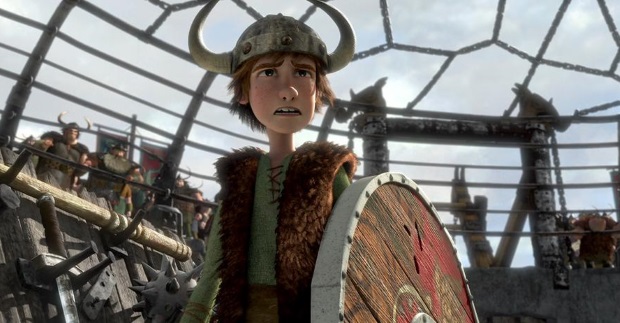
But Toothless is not what he appears to be – and neither, it turns out, is Hiccup.
It’s their unbidden friendship, and the growing realisation that they are better together than apart, that drives the story forward. Making Toothless larger means Hiccup can actually ride him and turns an emotional connection into a real, physical dependency. It also allows for some awesome flight sequences, more of which below.
Despite this larger-than-life premise, both characters feel real. Hiccup is smart but not annoyingly so, vulnerable but not feeble. He’s a conventional teenager in an unconventional society – though of course to the other Berkians, Hiccup is the unusual one. Always ready to deflate conflict with an endless supply of self-deprecating one-liners, he wants to be accepted for who he is – especially by his father, Stoick – but also wants to be one of the gang. And Toothless – well, let’s face it, he’s a very cool dragon. He’s as fierce as a panther but as playful as a pussycat, dangerous and enigmatic but single-mindedly loyal – who wouldn’t want him as a best friend?
Epic flight sequences
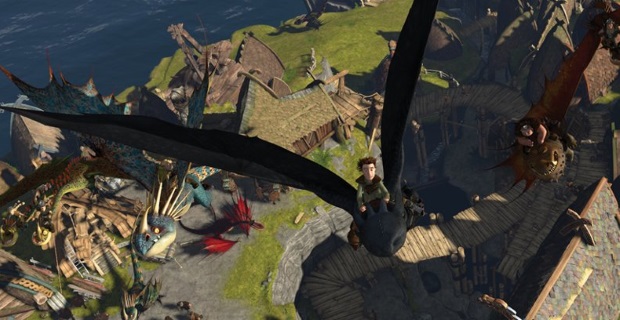
If you remember nothing else from the film once the credits have rolled, it’ll be the sheer exhilaration of Toothless and Hiccup’s flight sequences. All credit to Head of Character Animation Simon Otto, who put his animators through their paces in a pre-production “flight school” to make sure the physics feel real (and who brought in an ornithologist to advise on wing anatomy). As a result, the movement of Toothless in the air and the sense of wind buffeting his outstretched wings simply take your breath away. We feel the wonder and weirdness of natural flight, moving through vertiginous cloudscapes where all sense of human scale is lost, and – in the most spectacular sequence of all – going from sunset to night in one wildly disorientating loop-the-loop dive through the clouds.
Much of the action is filmed from the POV of riding on Toothless’ back, just behind Hiccup, which works brilliantly in drawing us into their relationship. We experience the drama just as Hiccup does. In fact, I challenge anyone to watch the sea stacks sequence (where the duo are unwittingly forced to try out their new-found and untested flying skills with potentially fatal consequences) without holding their breath in sheer anticipation and exhilaration.
John Powell’s Oscar-nominated score
It’s unusual for an animated film to be given the full orchestral treatment, but here the score perfectly emphasises the scale of the drama. It’s also a tribute to John Powell’s skill that it feels so integral to the film’s emotional heart.
Military-inspired drums and Celtic folk instruments frame the Vikings’ world, while sweeping string and horn arrangements echo the vast Nordic landscapes beyond Berk. When the characters soar, so does the score.
However, it’s in the film’s most intimate moments that the music really sings. Given that Toothless doesn’t speak (a canny decision by Sanders and DeBlois that helps move How To Train Your Dragon away from more traditional anthropomorphic Disney fare and into the realm of Miyazaki’s enchanting My Neighbour Totoro), it’s left to the score to underline the emotions of his scenes with Hiccup. These are never mawkish: the montages of a blossoming friendship are painted with the lightest of musical touches and really are a delight.
Equally, in scenes where Hiccup’s burgeoning relationship with Astrid (aspiring dragon-slayer, girl of Hiccup’s dreams, and seriously out of his league) starts to take off (again, literally), Powell’s score provides a swooning, romantic undercurrent that really bolsters the visuals. Astrid (America Ferrera) may be a hard nut to crack, but once she’s convinced of Toothless’ goodness, she’s totally convinced – as are we.
Roger Deakins’ visual input
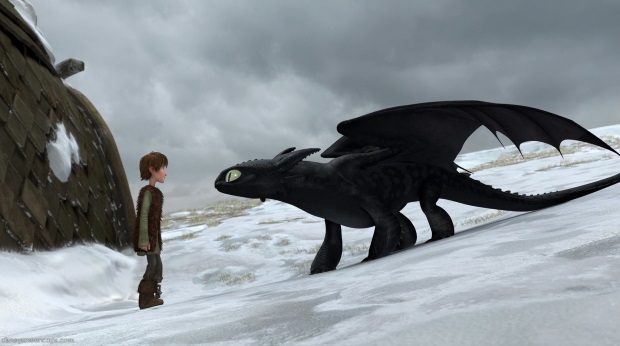
Bringing award-winning British cinematographer Roger Deakins on board as visual consultant was an inspired choice. Known for his simple but strong lighting and framing on films such as Skyfall, No Country For Old Men and Blade Runner 2049 (for which he, finally, won a well-deserved cinematography Oscar last month), Deakins brings a truly cinematic sensibility to this CG world.
Exterior shots of the Nordic landscape ooze with Deakins’ signature style: a misty, dripping forest where Hiccup first encounters his downed dragon feels looming and real, as does the ominous fog-bound seas that surround Berk. Many shots are framed with an emphasis on negative space (the space between characters and objects), allowing them room to breathe – and allowing us to really get lost in the scale of the Viking’s world.
Unusually for an animated feature, the filmmakers are confident enough to throw away their lovingly-rendered details into deepest shadow in interior scenes – which makes perfect sense in a Viking world lit only by candle and firelight. The results are desaturated, high-contrast images that create a real sense of intimacy. It’s the sort of attention to detail one might expect from an arthouse film but that’s rarely extended to animated fare.
It’s a stunning, enigmatic visual style that helps anchor the fantasy of the story in a compellingly real world.
A credible universe
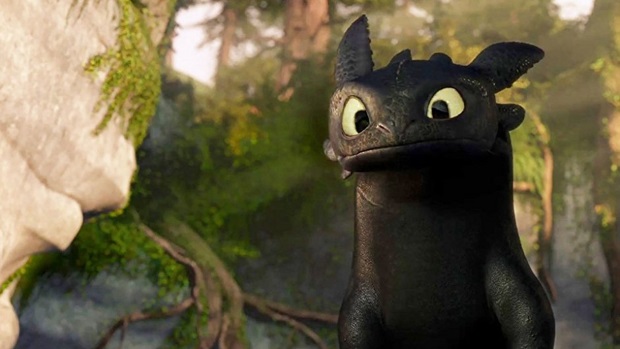
The world the Vikings inhabit also feels realistically lived in. Rocks are moss-grown, ships are covered in barnacles and the Berkians’ handspun clothes have definitely seen better days. Viking technology and architecture is charmingly eccentric – though seriously deficient when it comes to health and safety regulations. Both feel organic, as if they have emerged from the landscape over generations (incendiary dragon attacks notwithstanding).
It would have been easy for the filmmakers to contrast this rough-and-ready Viking world with fantastical, magical dragons, but wisely, the dragons’ characters are also grounded in real behaviours. Toothless’ facial expressions and body language, for example – which range from dagger-slit angry eyes via jaw-dropped astonishment to ear-flaps-up bemusement – are a joy to behold. (Props also to sound designer Randy Thom, who gives Toothless just the right amount of beastliness with his guttural, almost purring vocalisations.) All the dragon species we encounter are beautifully conceived, from the gronkle (a rock-swallowing, bumblebee-like dragon the size of a small car) to the swaggering, self-combustible monstrous nightmare.
The humans are just as sharply observed. Hiccup’s mannerisms and vocal tics (sweetly funny thanks to Baruschel’s wonderfully offbeat performance) set him apart from the more confident and outspoken gang of teenagers around him.
All of the main character have their own fleshed-out personalities, even Stoick (no pun intended). He could have been written as a one-dimensional authority figure, but is given depth in the frustration he feels with his un-Viking-like talking-toothpick of a son and his fears for the Vikings’ future.
Butler and Baruschel give naturalistic, spontaneous performances overlaid with beautifully-observed animation: witness, for example, Hiccup’s daydreaming, pencil-flicking moment just before Stoick bursts in on him to have a (hilariously misconstrued) chat. (Another gorgeous moment, almost too small to be noticed on first viewing, is Toothless’ minute hesitation in placing his muzzle against Hiccup’s outstretched hand at the climax of the Forbidden Friendship sequence.)
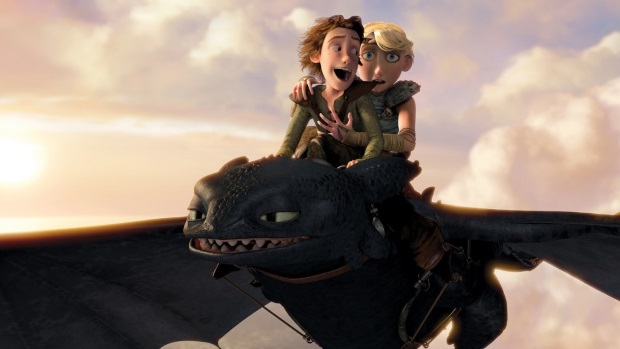
Outside the main characters, the Vikings of Berk are pretty much interchangeable in terms of looks and behaviour, and occasionally there are moments in the film when the animation of peripheral characters is distractingly formulaic. Indeed, with hindsight, it’s tempting to compare the CG of the first film with that of its sequel, How To Train Your Dragon 2 – and hard to deny that the latter film surpasses the original in this respect. In terms of its epic sense of scale, HTTYD2’s vfx are incredible (as is the attention lavished on the smallest of details: Stoick’s beard in the second film, each strand lovingly lit and rendered, is truly a thing of beauty). But no matter: technology moves on in four years, and for its time HTTYD’s CGI was cutting-edge. More importantly, HTTYD’s story is strong enough and intimate enough that technicalities doesn’t matter. Once we have bought into the Viking world, we are immersed.
A consistent tone and a tight script
How To Train Your Dragon hits the sweet spot when it comes to tone. It is understatedly funny with none of the snarky asides and throwaway pop culture references that have tripped up other DreamWorks features (Monsters Vs Aliens, anyone?). None of the story beats are signposted with a knowing nod to the audience: we’re allowed to discover answers at the same time as the characters on screen. Nor is the film afraid to use the absence of dialogue (and those beautifully sparse frames) to its advantage, giving the story time and space to grow.
Of course, How To Train Your Dragon goes for laughs too – it is a very funny film – but these moments grow from the characters and situations and don’t feel forced. Most importantly, the script is tight: none of the dialogue is superfluous and all the action drives the plot forward. The third act escalation – the discovery of a looming threat much larger than anything the Vikings could have imagined – turns up the tension with just the right degree of peril. All of which means that, when the story comes to its conclusion, we are fully invested in our heroes and cheer them on to the finish line.
A film with heart
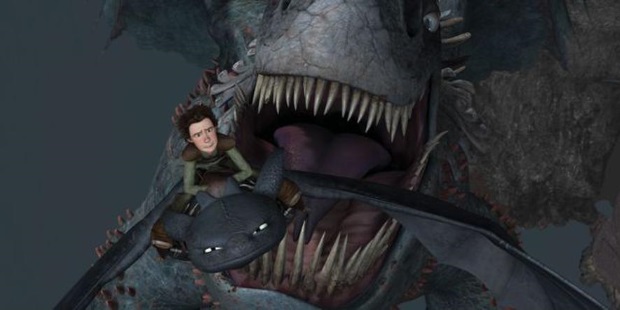
If How To Train Your Dragon has a message it’s this: that vulnerability can be turned to strength and that we are better together than alone. What seem like weaknesses – Hiccup’s sensitivity to the dragons’ fate at the hands of the Vikings, Stoick’s worries as a father and chief, Toothless’s fearsome reputation – are all turned to strengths when our characters accept who they really are and stop pretending to be something else. Hiccup fails to kill the downed dragon in the woods, but this, ultimately, is the making of him and the salvation of Berk. Astrid learns to start questioning Viking dogma and see people for who they really are. Stoick learns to trust his son’s (and his own) intuition.
But in case these sound like sugary happy endings, I can tell you that they come at real personal cost. Hiccup in particular (in a neat inversion of Toothless’ incapacitation at the start of the film) pays a heavy physical price for his new-found friendship. I won’t give the ending away – that’s for you to discover if you’ve not yet seen the film – but suffice to say in test screenings this was the part of the film the audiences were universal in praising, saying it sent a powerful message of inclusivity and acceptance. And what more can you ask from a film in 2018? If you’re not smiling by the time Jonsi’s infectiously upbeat song Sticks And Stones plays over the end credits you’re a harder-hearted person than me.